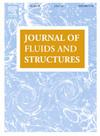An unsteady aerodynamic reduced-order modelling framework for shock-dominated flow with application on shock-induced panel flutter prediction
IF 3.4
2区 工程技术
Q1 ENGINEERING, MECHANICAL
引用次数: 0
Abstract
A fully data-driven unsteady aerodynamic reduced-order modelling framework based on the nonlinear autoregressive with exogenous input structure is established for fluid-structure coupling simulations in the shock dominated flow. A generalized radial basis function neural network extended with polynomials is used for mapping the regressors and model outputs. The training with validation techniques is adopted to enhance the model's generalization ability, and the Bayesian optimization algorithm is selected for hyperparameter tunning. In addition, the fluid-structure coupling is incorporated into the validation process with a modified loss function to improve the robustness of the trained models. Both a generalized aerodynamic force model and a proper orthogonal decomposition based distributed aerodynamic force model are constructed and tested for the prescribed surface motions and fluid-structure coupling simulations. The results show that the constructed models have high accuracy in the forced oscillation tests, and the predicted amplitudes and frequencies of limit cycle oscillations in the shock-induced panel flutter are in excellent agreement with computational fluid dynamics/computational structural dynamics coupling simulations. The statistical results show that the online computational cost of the reduced-order model are orders of magnitude less than that required for the computational fluid dynamics method, indicating the presented modelling framework is an effective tool for the shock dominated aeroelastic problem analysis.
一种非定常激波占主导的气动降阶模型框架及其在激波致板颤振预测中的应用
建立了基于外源输入结构非线性自回归的全数据驱动非定常气动降阶建模框架,用于激波主导流的流固耦合仿真。利用多项式扩展的广义径向基函数神经网络映射回归量和模型输出。采用验证技术训练增强模型的泛化能力,超参数调谐选择贝叶斯优化算法。此外,通过修正损失函数将流固耦合纳入验证过程,以提高训练模型的鲁棒性。建立了广义气动力模型和适当的基于正交分解的分布式气动力模型,并对规定的表面运动和流固耦合进行了仿真试验。结果表明,所建立的模型在受迫振动试验中具有较高的精度,所预测的板颤振极限环振动幅值和频率与计算流体动力学/计算结构动力学耦合仿真结果吻合良好。统计结果表明,该降阶模型的在线计算成本比计算流体动力学方法的在线计算成本低几个数量级,表明该模型框架是分析激波主导气动弹性问题的有效工具。
本文章由计算机程序翻译,如有差异,请以英文原文为准。
求助全文
约1分钟内获得全文
求助全文
来源期刊

Journal of Fluids and Structures
工程技术-工程:机械
CiteScore
6.90
自引率
8.30%
发文量
173
审稿时长
65 days
期刊介绍:
The Journal of Fluids and Structures serves as a focal point and a forum for the exchange of ideas, for the many kinds of specialists and practitioners concerned with fluid–structure interactions and the dynamics of systems related thereto, in any field. One of its aims is to foster the cross–fertilization of ideas, methods and techniques in the various disciplines involved.
The journal publishes papers that present original and significant contributions on all aspects of the mechanical interactions between fluids and solids, regardless of scale.
 求助内容:
求助内容: 应助结果提醒方式:
应助结果提醒方式:


